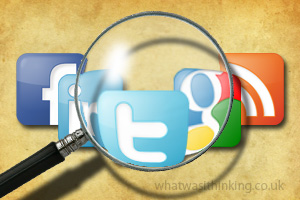 A few months ago I gave a talk in London about the use of social media for travel and tourism industries, which I think was very well received (considering I received no complaints but follow-up questions I take that as successful), and one of the key questions that was asked a couple of times was – should brands monitor what is being said about them? Why should they? Is it worth the effort? What do you focus on? How would this be monitored? And more importantly, is there an ROI to be taken from this? So, I thought I’d begin a little set of articles about this.
A few months ago I gave a talk in London about the use of social media for travel and tourism industries, which I think was very well received (considering I received no complaints but follow-up questions I take that as successful), and one of the key questions that was asked a couple of times was – should brands monitor what is being said about them? Why should they? Is it worth the effort? What do you focus on? How would this be monitored? And more importantly, is there an ROI to be taken from this? So, I thought I’d begin a little set of articles about this.
.
Why monitor your brand on social networks?
Before we answer this, let’s take back a step and talk about what we are actually talking about. Monitoring your brand is essentially the continuous discovery of conversations related to your brand with the purpose of engaging and supporting not only your brand, but also your (in many cases potential) customers. Typically, this is done in real-time to allow immediate response to particular topics or situations, e.g. when launching a product, quelling rumours or – just as often – providing support or advice.
Already, we have a few reasons listed that might answer the “why”. But let’s take a more real-life example: say for argument’s sake that you are having a launch event of a new product, and you have invited hundreds and hundreds of people from all over the spectrum (press, business partners, customers, just random people off the street interested in the product, etc). All of them want to talk about the product, some of them want to talk to others about things related to it, some of them are just here to mingle and pick conversations or comments up (or leave their own comments).

Many of these conversations may be about your brand or your product, some might be about a similar brand or in fact a similar product to yours, be it superior or inferior doesn’t really matter. What matters is the fact that they are talking about this without you being part of these conversations to learn more or answer questions, they happen with or without you. And to provide a better service, help customers and partners understand more and to prevent potential problems it might be worth keeping an eye out on what people say about your brand or your products.
The same is true for any kind of brand, be it a car manufacturer or a destination, at the end of the day no one is going to buy your car or visit your destination if people aren’t happy about it and leave bad reviews or comments.
whatwasithinking.co.uk
Measuring your brand
Continuing right on from that, we come to the how. We all know that social media is essentially a massive open forum for people to share opinions, news and comments. We now we want to see what is going on and how we can measure it. It is most likely that you need to report on your product’s and brand’s performance with some sort of KPIs, and you will need to benchmark not only the quality of your product but also the consumers’ perception of it, and through it your brand. Social media expands and evolves quickly, and you will need to have something in place to measure and respond to threats and opportunities quickly.

NB: I mention product a lot, but you can easily replace the word product with destination and you’ll see the same rings true here.
Typically, social monitoring is performed on a keyword or key phrase basis (SEO anyone?). These keywords and phrases include your brand name, your key product(s), maybe even competitor brands and keywords. Going on from that, you will want to decide on which networks to monitor and let a tool (or people) loose on finding relevant articles, comments and questions. This information needs to be in a form that allows you to drill down right to the network, time and – if necessary – the source to allow you to act upon.
This kind of measuring is crucial to track your brand’s and product’s success over time, it enables you to draw conclusions and plan actions on (in some case real-time) factual data based on your marketing campaigns, and it allows you to draw comparisons between the success of your marketing and the brand and marketing of your competitors. Not only that, it enables you to respond to threats and opportunities in a timely manner.
whatwasithinking.co.uk
How to monitor your brand on social networks
A very important part of monitoring your brand or destination in social networks is to find a structure that works. Here are a few pointers that might help you:
- Focus on key topics for your brand. These topics need to tie in with what your brand is about and what your product is used for – for destinations these topics could range from family holidays over culture seekers to single travellers or backpackers. For a product it could be the types of people using it or the activities associated with it.
- Find out what do people already talk about. This is a question not many destinations / brands ask. People are already talking about something when it comes to your brand / destination, and it may not always be the standard features or sightseeing places, but it could be hidden away gems, interests, problems or work-arounds.
- Establish what is bad about your destination / brand / product? Who is saying what and why?
- Establish what is good about your destination / brand / product? What can you build on?
- Establish what isn’t even mentioned? Do you have a campaign running no one is actually talking about? Are you offering particular promotions / places of interests that no one is actually making use of / visiting or sharing any information about?
- Understand what it is you’re tracking and how to use the tools. I spoke to a client recently who used some very expensive licenses for their social monitoring software, but they weren’t actually using it to their fullest potential or how to tie this in with their own CRM and campaign solutions.
- Analyse your data!
- Make sure you are using correct numbers: plan in which metrics you actually want to track, and how these are being reported and compared.
- Make sure you act! Gathering data is not really useful if no one actually does anything with it.
whatwasithinking.co.uk
___________________
Next steps
Going forward, my next articles in this series are going to be talking more about the How – how to monitor your brand / destination on social networks, what to look out for, how to gather and make use of collected data, and how to respond to consumer / competitor feedback and comments. Stay tuned!
Pingback: Why monitoring your brand on social networks is important - All News & Campaigns.
Sarah
March 4, 2012Another great article Alex!